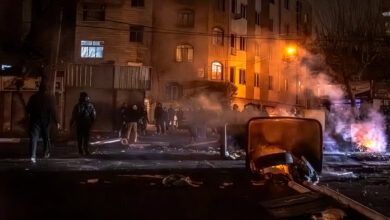Khayamiya is located at the end of Moez Street, north of Bab Zuweila. Khayamiya is derived from the Arabic word Kheima, which means tent. Khayamiya is the art of tent-making.
Khayamiya is a long, narrow, covered corridor between two historical buildings in Darb al-Hahmar district. It consists of little nameless shops that sell the same products: khayamiya handmade cloth, cushion covers and tablecloths. The variety of colors and designs is what makes this place unique.
Recent political events have left tourism in Egypt considerably diminished and touristy areas such Khayamiya have suffered. “We rarely sell these days; may be one transaction per week,” says Aam Kamal, a shop owner. Due to low demand, wholesalers have raised the prices of fabrics, which makes it harder for Khayamiya craftspeople.
“Even bazaar owners in Sharm el-Sheikh stopped their dealings with us,” says Kamal Abdel Tawab, another owner. He complains about the lack of safety in his neighborhood and fights that break out around his shop on an almost daily basis.
As I walk along the beautiful covered passage I hear a bored shop owner yelling "el-agala wa’afa!" (the wheel of production is stopped).
Mohamed owns a shop for tent supplies in the heart of Khayamiya; he welcomes us with a friendly face and swears we are his first customers since the morning. “I provide supplies to hotels and touristic boats and my entire income depends on tourism,” says the young man.
He complains about the constantly rising prices of raw material; according to him, Egypt exports its highly-regarded good quality cotton and imports cotton of a much lower quality from Syria and China. “I receive fabrics from Mahala four times a week."
“People are scared and don’t make big purchases nowadays and rarely carry lots of money outside their houses,” he says, adding that customers now weigh their priorities and most pay half up front and the rest after a few months!
Behind Khayamiya is Wekalet Radwan Beih (also known as Wekalet Othman Shomar); a small, primitive industrial area that dates back to the Ottoman era. “Most of the workshops here are rented from awqaf (the ministry of endowment),” explains Khaled Ahmed, one of the owners.
Ahmed is the last in a long line of carved glass manufacturers. “I own this workshop with my brother and together we can only finish one piece a month,” explains the artist. There are a few ornamental mirrors and old carved glass pieces laying around. One hundred percent handmade, they are expensive: a 100 by 160 cm mirror costs around LE 4000. “The customer for such beauty has become extinct,” complains the young worker.
Nowadays Ahmed mainly works on restoring antique pieces; “The last piece I worked on had the stamp of King Farouk,” he says proudly.
Every now and then Ahmed and his brother start work on a piece and store it in their little workshop to wait for a wealthy customer with taste who can appreciate their talent and cherish their art. “I want to pass on the skill to others; in 50 years this craft could be extinct and this LE 4000 mirror would cost LE 50,000.”
Despite the beauty that emits from this place and its people, there is a peculiar wretchedness residing between these walls, the grief of uncertainty. Will this beautiful art see the light of tomorrow?




